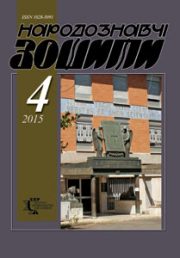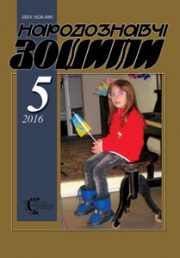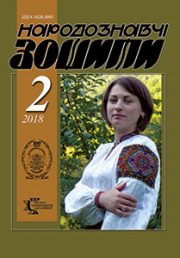The Ethnology Notebooks. 2023. № 3 (171), 690—696
UDK [378.4.016:7]”18/19″:7.071.1-021.414
DOI https://doi.org/10.15407/nz2023.03.690
THE ROLE OF PROFESSIONAL CRAFTSMEN IN ART AND INDUSTRIAL EDUCATION
DYACHENKO Alla
- ORCID ID: http://orcid.org/0000-0003-4496-5931
- Candidate of Pedagogical Sciences,
- Associate Professor of the Department of Industrial Design
- and Computer Technologies, Acting Dean of the Faculty of Decorative and Applied Arts,
- Kyiv State Institute
- of Decorative Art And Design Named by M. Boychuk,
- 32, M. Boichuka (Kikvidze) St., 01014, Kyiv, Ukraine,
- Contacts: e-mail: alla.diachenko0107@gmail.com
Abstract. The article describes the contribution of professional masters to the formation of artistic and industrial education in the late XIX and early XX centuries. The activity of V. Rozvadovskyi as the founder of the art and industrial school in Kamianets-Podilskyi in 1905 on the territory of Right-Bank Ukraine is also discussed. Thanks to the traveling national exhibitions of paintings, Viacheslav Rozvadovskyi and his associates managed to lay the foundation for the establishment and development of Kamianets-Podilskyi drawing classes with a ceramic department. In 1908, this school was renamed into an artistic and industrial training workshop, and Mykola Root was appointed as its head. He attached particular importance to the study of special subjects and practice. From 1916 to 1933, the workshop was headed by Volodymyr Hagenmeister, who created his own publishing house, a lithographic workshop. The workshop produced albums, collections, booklets, and postcards. Opanas Slasten worked as a teacher of drawing at the Myrhorod Art and Industrial School, and devoted a lot of energy and effort to training qualified specialists. During his many years of teaching, he trained many artists and ceramists, and was engaged in artistic painting on ceramics. Pavlo Andriiovych Dubynskyi, a graduate of the Myrhorod Art and Industrial School, headed a pottery school in the village of Makariv Yar, Novosvitlivskyi district, Luhansk region, which was opened in 1927 on the initiative of the District Inspectorate of Public Education. Pavlo Dubynskyi organized the educational process, and his students were active participants in all the production processes of pottery. Oleksandr Statyva, Tetiana Pata, and Marfa Tymchenko devoted their activities to Petrykivka painting, and they worked in art institutions. They developed methods of painting porcelain and wood products, prepared sketches of designs for fabrics together with other Petrykivka craftsmen. A galaxy of artists and educators of the late nineteenth and early twentieth centuries made a significant contribution to the development of artistic and professional schools in Ukraine. Their activities were aimed at satisfying the interests and requests of students, mastering certain skills and knowledge.
Keywords: art and industrial school, V. Rozvadovskyi, M. Root, V. Hagenmeister, O. Slasten, P. Dubynskyi, O. Statyva, Petrykivka painting masters.
Received 2.06.2023
REFERENCES
- Huleikova, O. (2021). Formation and Development of Artistic and Industrial Education in the Cultural and Educational Centers of Elisavetgrad (second half of the nineteenth — early twentieth century). Kyiv [in Ukrainian].
- Synyshyn, L.O. (2019). Development of artistic and industrial education in Galicia (late XIX — first half of XX century): PhD thesis. Precarpathian National University, Borys Grinchenko Kyiv University. Kyiv [in Ukrainian].
- Shmahalo, R. (2017). Historical milestones of the artistic and industrial school in Lviv in the context of the development of world art education in the second half of the XIX—XX centuries (Issue 31, pp. 9—25) [in Ukrainian].
- Ovcharenko, L. (2017). Pottery schooling as a determining factor in the creative development of Ukrainian traditional pottery (1894—1941): monograph. National Academy of Sciences of Ukraine; Institute of Ceramics: a department of the Institute of Ethnology of the National Academy of Sciences of Ukraine. Opishne: Ukrainian Ethnology (Pottery schools of Ukraine: academic ceramics series. Issue 3) [in Ukrainian].
- Sholukha, O.M. (2015). Formation of the Myrhorod School of Art Ceramics in the Late XIX — Early XX Centuries: At the Crossroads of Influences. Art historical notes (Issue 27, pp. 344—354) [in Ukrainian].
- Ovcharenko, L. (2014). Public exhibitions of paintings by Vyacheslav Rozvadovsky (1904—1906). Ethnic history of the peoples of Europe (Issue 43, pp. 52—59) [in Ukrainian].
- Hagenmeister, V. (1930). Peasant wall paintings of the Kamianets region: Materials for the study of Ukrainian peasant art. 1917—1927. Kyiv; Petersburg [in Ukrainian].
- Catalog of publications of the Kamianets-Podilskyi vocational school named after H. Skovoroda. Retrieved from: https://archive.org.ua/archive/2008-06-06/heritage.com.ua/spadshina/mystectvo/index.php?id=651 (Last accessed: 25.05.2023).
- Studenets, N. (1997). Folk paintings in the publications of the Kamianets-Podilskyi Art and Industrial School. Folk art and ethnography, 2/3 [in Ukrainian].
- Sholukha, O.M. (2015). Formation of the Myrhorod School of Art Ceramics in the Late XIX — Early XX Centuries: At the Crossroads of Influences. Art historical notes (Issue 27, pp. 344—354) [in Ukrainian].







